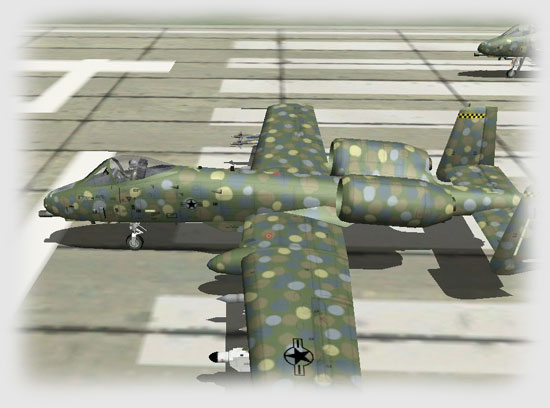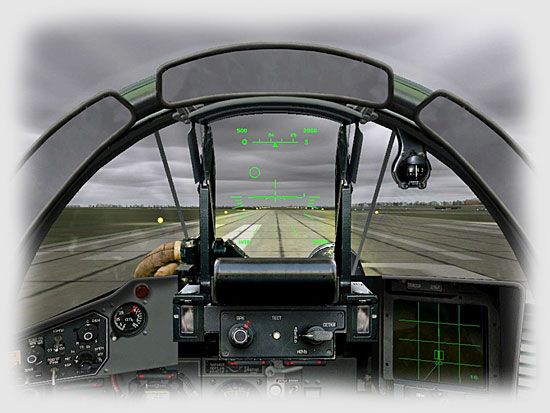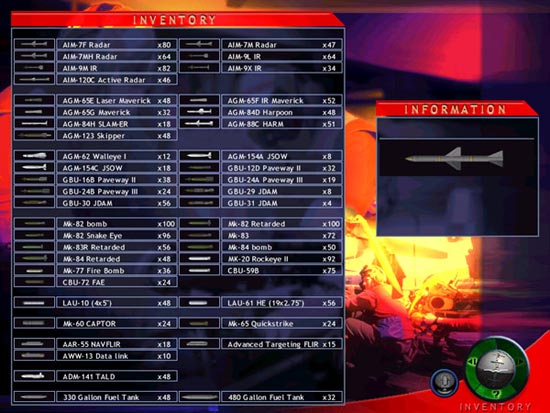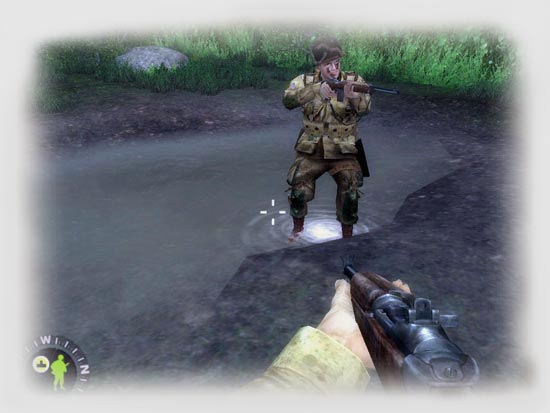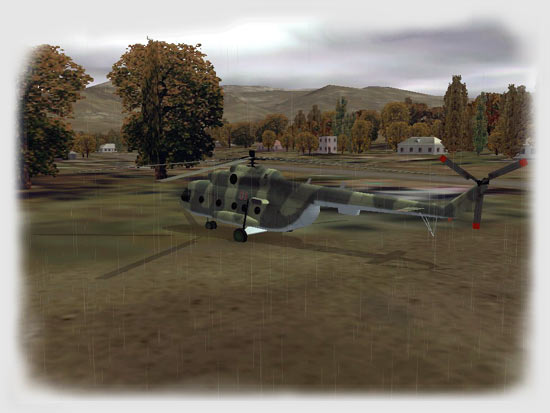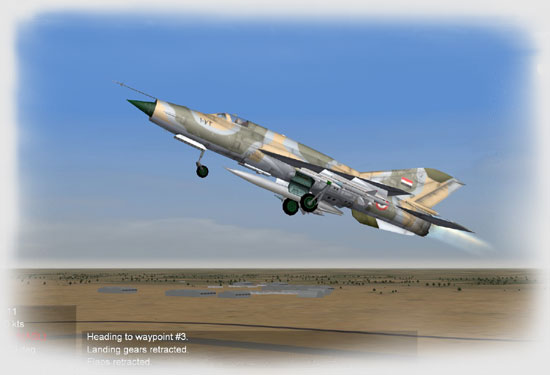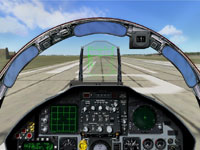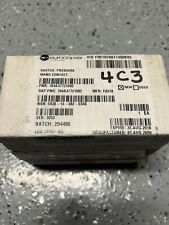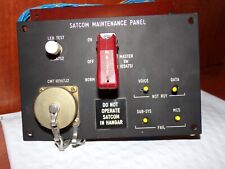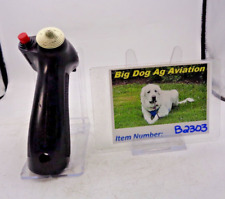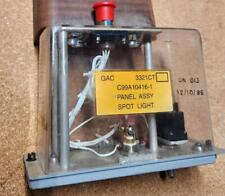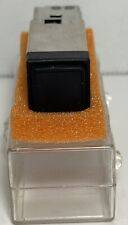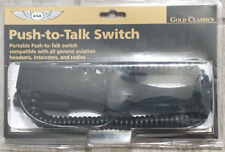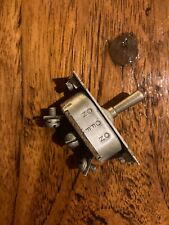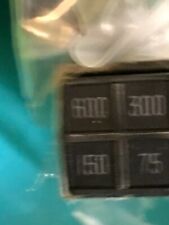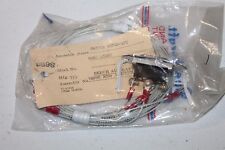by “Cat”
Screenshots by “Thomas DW”
Adler Military Airbase, Sochi, Russia
Wednesday, November 25, 03:30 hours
One of the holidays that is not often celebrated in Russia is your Western holiday of Thanksgiving. With the changes in our country since the fall of the Soviet Union, however, we are coming to know more of your traditions, and there is much interest in your holidays. We Russians love our holidays! You might say, “any excuse for a party,” da? But it is true! We are not the dour fatalistic people that we are often caricatured to be. At least, for the most part that is so. Nevertheless, I recently came to know your holiday well, for this season I have much to give thanks for.
You know of my… I have not the words… strast’yu popast’ v bedu? A… passion for trouble, da? And even when I do not look for it, trouble finds me. And so it was that I came to know your custom of Thanksgiving. For this, I blame the Americans. But with tongue in cheek. For it is they who saved me from my misadventure.
The world is not a peaceful place. And as a world leading power, Russia is ever at the forefront where there is unrest. And so it was that I found myself in a very unaccustomed role: Courier. These calls always come in the early morning, and I found myself being shaken awake none-too-gently just as the sun began to peek over the eastern horizon. It was not too cold out, about seven or eight degrees or so, I think. Still, I had not planned to fly that day and it took a very long moment to remember where I was! By this time, I was made the second in command of our Regiment; I have been made a major, and I have administrative responsibilities. But this mission would take priority. As I swung my legs over the side and shook the sleep away, the lieutenant who had been sent to retrieve me could not contain himself and told me all.
“Major, it is a diplomatic dispatch, in a red cover! The Commander says that you are personally to fly it, and you are directed to obtain an Su-33 from the special operations wing!”
I thought I had misheard. The 503rd’s Su-33 aircraft are rare and special. Some have been modified greatly. Some are the very Su-27K aircraft that I flew as a test pilot at Saki thirteen years ago. There are 24 in our inventory, and of those, nineteen serve at sea. The other five, they are here at Sochi. I have a total of five arrested landings, you know, on our aircraft carrier, Admiral Kuznetsov’! All Su-33 have two things in common: longer range than the MiG aircraft we usually fly, and the capacity for air refueling. This package needed to go far, and go there quickly. Thus, I was sent to retrieve a Crane, that beautiful water-borne bird, and fly it once more.
But where, eh? Opening my locker, I took out my white ZSh-7 helmet and KM-36 mask, packing them carefully in my bag that already had my NPL whiteboard, my binoculars and charts, my bootleg Garmin hand-held GPS device, and my modified American mesh survival vest, as I listened to my lieutenant rush through what he knew. Our flight gear has changed much since we last spoke, my friends, but in some things I am a traditionalist. Often, our pilots wear coveralls and the same sort of “speed jeans” that Western pilots wear. I still favor my venerable VKK-15K bib-type coveralls. They go on right over the gray T-shirt and gym shorts I sleep in and have the inflation equipment built right in! With the olive-drab coveralls and my Hi-Tec flying boots (another thing I have picked up from the Americans) zipped up, I flipped my hair over my head, running a brush through it as I considered the news my eager lieutenant had delivered.
“Misha, did the Commander tell you my destination? Or is that the one thing he keeps a secret?”
“Nyet, Major. He waits for you in his office, for the briefing, even now.”
Securing my hair, I pulled on my vest and my 9mm Makarov’s holster, and slipped the VKK-15’s jacket over one shoulder. It is the same olive-drab as the coveralls. I have our Russian flag patch sewn on the left shoulder, my name tab on the left chest, and our brightly colored squadron patch on the right chest. My rank tabs are on the shoulders, dark blue with two light blue stripes and a large gold star. I often wear this jacket even when I am casually dressed, it is an old friend. It has a waterproof hood zipped into a pocket behind the ribbed turtleneck collar, and it has elasticized wrist warmers of the same material as the collar too. And it has many pockets! It is a size larger than the coveralls, to accommodate my vest, which I wear underneath it. I have had the parachute riggers modify my American survival vest with openings to pass the hoses for the inflation and cooling equipment in my coverall through to the zippered opening in my jacket.
Time to go. Misha leads the way out, into the cool morning air. I suspect it will be warmer where I am going. I have packed an overnight bag with my regular duty uniform and soft-cap, and some essentials as well, just in case. The Commander is pacing when I arrive. From the look of the overflowing ashtray on his desk, he does not like this mission; it is overflowing with the harsh, Turkish cigarettes he favors.
“Ah, my little falcon. Are you ready for your trip?” He regards me knowingly. As for me, I am always ready to fly, and I affirm that this is so.
“Good. Attend.” He nods to his attaché, who competently rattles the keys to a solidly-built portable computer atop the Commander’s antique-wood table. Light projects to the whitewashed wall behind the Commander; it is a map with which I am familiar. I have flown these perilous skies before.
“The diplomatic package must be delivered to our consul in Kuwait City. You will be met at their international airport. Time is of the essence. I do not know what it contains, but it is vital that it get to its destination quickly.”
“Then I am to fly this mission alone?” I am hesitant. A mission so sensitive should have at least one other aircraft.
“Da. It is thought that one lone aircraft will not attract attention.” The Commander’s tone made clear that he did not agree with that assessment. “The Su-33 is here, so we will not have to request a special delivery of an aircraft for you from one of our other bases in Russia. You are rated for it, and it has the range necessary for this trip. Plus, it can be refueled in the air if necessary, and there will be an IL-76 tanker at Batumi, which fortunately for us we liberated from the Georgians in the last war. Batumi is near enough for our purposes.”
He handed me a small, plastic-wrapped item, no larger than a stick of chewing gum. “This ‘biscuit’ contains a special, single-use code. The person you will meet at the airport will have the countersign that matches it. None here know what it is, Sacha, and you must not open it until you arrive. By it, you will know that you have arrived at the proper place and are transferring the package to the proper person.”
“The rules of engagement?” This is critical to me. I need to be able to defend myself, if necessary, and I do not know who might want to prevent me from reaching my destination.
“Self defense is permitted. If you are locked by a fire-control radar, be it American, Turkish, Syrian, even Iranian, it does not matter. The package must not fall into the wrong hands, and you may take whatever action necessary to complete the mission. If you are forced down, protect the package at all costs. Destroy it as a last resort, it is water-soluble.”
The package is wrapped in red cellulose. It is small, only about 3” by 5”, and easily slips into the inner zipper pocket of my VKK-15 jacket. It is clearly marked and sealed as a diplomatic message, and therefore it should be respected by most customs personnel. I stand to attention and salute, about turn, and smartly march out. The GAZ jeep is waiting to whisk me away to Kolya, our longtime meteorologist, who is waiting to brief me on weather conditions in the south. I will have to transit Turkish airspace. Permission has been granted for this, according to the papers in my mission brief, but still, it concerns me. Many Turks are dead by my hands in our war with the Wahabbist mujahids of the IRLF, and even though I have made my peace and count many of the Turkish military among my friends now, we are still tense on our borders. Our incursion into Georgia last year won us few friends.
Kolya lights every room he enters with his smile. He is unfailingly gracious, with his tall glasses of tea and fresh slices of cucumber, and his maps and charts. So studious! He laughs as he tells me that in Kuwait City, it is over 20 degrees and clear for miles around! Everyone will be jealous; in Adler it is gray and cloudy, often, and the temperatures hover around seven or eight or so. As well-traveled as I am, would you be surprised to find that I miss these men when I am away from them? That I miss Sochi dreadfully? Christmas is not too far away, and my family plans to gather here for the holiday.
I must push such thoughts from my mind. It is time, and I don the IPS-72 harness over my flight gear. Senior Lt. Kulikov, my usual plane captain, waits with the ground crew from the 503rd that has prepared the aircraft. Major Grachev of the special detachment meets me at the hangar with documents for me to sign, to transfer-temporarily- this Su-27K to the 586th. He squeezes my shoulder in a fatherly way; we have come to know one another well over the years. And then, up the ladder and into the office.

I know this place well. It is comfortably familiar. This is not one of the modified aircraft, other than the ability it has to change the head-up display between English and metric measurements. It is a standard Su-27K, what you Westerners call the Su-33, with the same N-001 radar I have become so used to. I can hear Kulikov in the headphones, and I run through the boot-up for the aircraft’s computer, then do the dance with the controls for him. This little zhuravlik, the Crane, he is ready to leap for the sky. At Kulikov’s motion, I engage the left engine, hearing the AL-31 turbofan howl to life with a rising whine; APU power is disconnected, and I am on internal power now as I bring up the right engine to match it. Chocks away! I cross myself, flash Kulikov a thumbs-up and return his perfect salute. It is time. Moments later, I am on the runway, and the Su-27K leaps for the sky at my command.
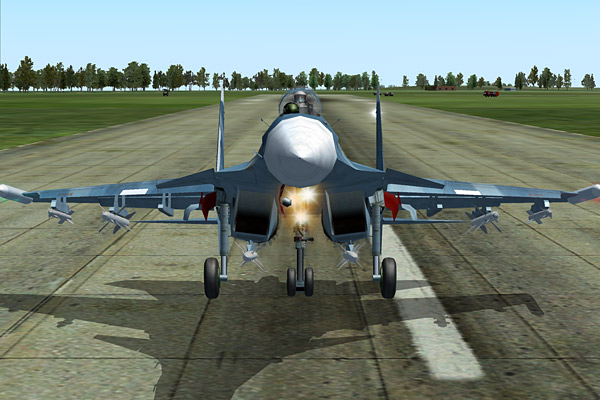
The 27K has canards forward. It is marvelously maneuverable; more so than even the MiG! Do you know, I have flown with the great Pugachev? I can do the “Cobra” maneuver he is famous for, though such showy performances are forbidden. The local A-50 acknowledges my presence, and vectors me south, handing me off to air traffic control.
![]()
U.S.S. Abraham Lincoln, in the Persian Gulf
Wednesday, November 25, 05:30 hours
“Wake up, Rabbit!” The shout in his headphones caused Lt. junior grade Wendell Oliver to jerk awake, smashing his HGU-68 helmet into the canopy railing.
“Shi….!”
Now the man in his ‘phones started laughing. “Nappy time’s over, son.” Lieutenant Commander Jefferson “Tigger” Tyler, one of VFA-15’s brain trust. He was the one who’d hung the call-sign “Rabbit” on Oliver in the first place, thanks to Oliver’s habit of eating carrots and celery as a snack. “If you’d eat something other than that rabbit food you might be able to stay awake! Now get with it, we’re launching in five per the daily ops plan.”
That bouncy good humor and the accompanying laugh was how Tigger’d got that name. It annoyed hell out of their C.O., especially during early-morning Alert-5s. Now they only had five minutes to get their crap together, and Rabbit started his checklist. Tigger, on the cat next to him, was already starting engines. They’d shoot off the deck, climb to altitude, and then start turning lazy figure-eights above The Boat, waiting for that call from the Hawkeye providing long-distance eyes for the task force. Another long day. The day before Thanksgiving, far from home, and with everyone nervous about the Iranians.
Flipping switches, Rabbit muttered sotto voce,“if one more goat-eating bastard points his nose this way….”
“You’ll wait for me to clear you hot before you do jack,” Tigger finished. “Stay frosty, Rabbit. This ain’t no game. And cut your mic off vox.”
“Nuts.” Rabbit made the adjustment, and rolled his head on his neck as the plane captain led him through the dance, deflecting the Super Bug’s controls up, down, left, right. At the director’s signal, he sounded off, “Retract launch bar, off brakes!” He slammed his throttles into the stops, showed the cat officer his hands to confirm he was off the controls, snappily saluted, flipped on his nav lights, and grabbed the Jesus handles on the canopy bow. “I hate this part,” he muttered to himself.
Zero to flight speed in half a second. A giant hand slammed Rabbit back into his ejection seat as the Super Hornet rocketed down the track and off Lincoln’s bow. “Airborne!” he choked out as the F/A-18 stabilized and began to gain speed and altitude. Working smoothly now, he trimmed and set power for climb. “Seven miles. Two-point-five, and arcing,” he radioed back to the carrier, passing 2,500 feet and turning onto the ten mile arc for their departure radial. He formed up precisely with Tigger, who called in the next turn as they approached it. “Mercury 6 established outbound 335.”
![]()
Bandar Abbas, Iran;
Wednesday, November 25, 08:50 hours
Sirens wailed on the Bandar Abbas airfield. Four F-4E Phantom aircraft taxied out, drowning out the siren with the scream of their J79 turbojets. One by one, they taxied for the active runway, lining up, and blasting into the air under full afterburner. Each one was loaded for bear with Sparrow and early Sidewinder missiles. These men meant deadly business.
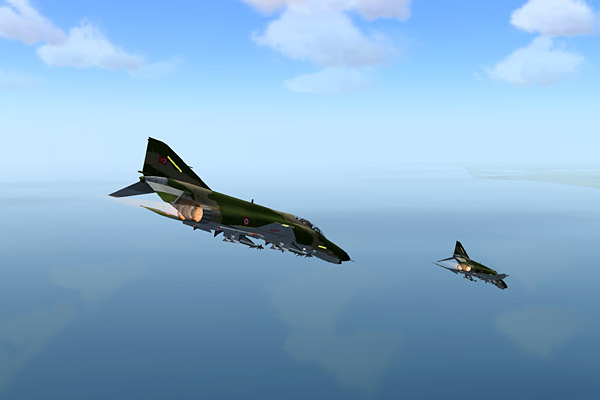
Forming up above the base, their leader gave curt, rapid-fire instructions in precise Farsi. The weapons systems officers in the back seat of each Phantom brought online their ancient APQ-120 radars and began searching for their target.
![]()
Over the Persian Gulf,
Wednesday, November 25, 09:00 hours
“Mercury 6, snap 105 for 100 for a flight of four bogeys outbound Bandar Abbas, angels 5 and climbing, 250 knots and accelerating, designate Sierra-1.”
“Roger, Mercury 6-1.” As Tigger turned onto the radial, the voice of the task group commander came up.
“This is Alfa Kilo. Stand down, Mercury 6, until you hear further from me. Sierra 1 is northbound and no threat at this time.”
On the Hawkeye cruising high above, the two officers in the back manning the consoles looked at each other, shaking their heads. Suddenly, a new contact became visible.
“Uh oh.” The controller keyed his mike. “Alfa Kilo, Eyeball. Contact 355 for 145, angels ten, speed 500, IFF negative, positive squawk, I designate Uniform-1. Looks like Sierra-1 is heading that way, sir.”
“Keep me advised.”
![]()
My SPO-15 radar warning system warns me of multiple military radars ahead of me. I study the flashing lights intently. The most worrisome are a set of airborne radars below me and to the left. According to the return, they are closing and the most powerful. I activate my N-001 radar, selecting DVB PPS long-range head-on sorting mode, slewing the dish to the left zone. There, I see them. They appear to be closing on me, fast. Suddenly, the SPO-15 rang an alarm, radar lock! They plan to engage me! Then, the SPO-15 screamed its warning of a missile launch!
“Der’mo!” Yes, I swear, sometimes. I know I should not. But here, someone is trying to kill me! I at once activate the SPS-171 Sorbtsiyajamming system, and smile like the wolf into my KM-36 mask as the enemy radar stutters silent, the incoming missile losing guidance.
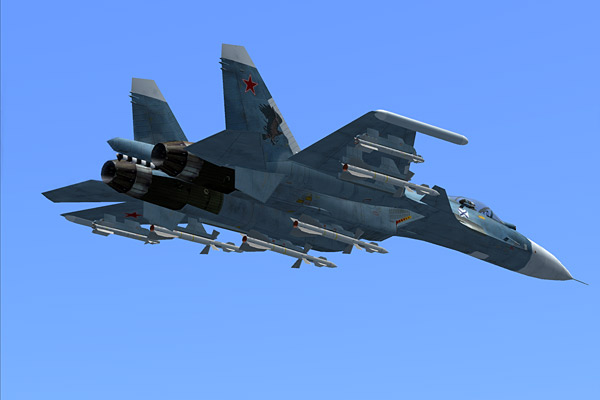
“Now, little pigeon. Let us see if you like to receive as well as give.” Yes, I decide to return the favor, and twist the rotary switch into DVB-SNP master mode. The N-001 at once designated the target with fastest closing velocity. Immediately, the N-001 sensed that we were well in range of my R-27RE missiles, and command-locked!

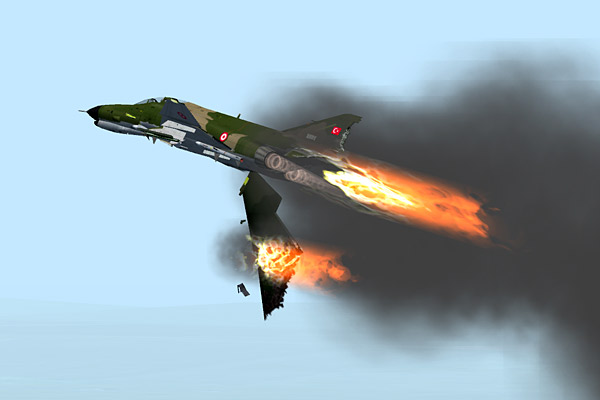
“Proklyat’e!” You must admit that I am justified in losing my temper, when the wily enemy jams me! Jamming strobes fan out across my HUD, the lock lost. I hope this enemy does not have the lock-on-jam capability. Because I do have the lock-on-jam. The brief lock I had gave me the target’s range. I set it manually, changing my radar’s pulse-repetition pattern to avtomat, to interleave medium and high PRF for the quicker burn-through, and loose a two-missile salvo, one R-27TE infrared-guided missile, followed by the radar-guided R-27RE. I carefully begin maneuvering to defeat the enemy missile, in case it homes on my jammer.
Who will burn through first? I can see the enemy radars, searching for me. We are in what Americans call the “F-pole joust,” now. Like the knights of old on their chargers. This is “chicken” in its truest form. Whoever loses the nerve first will die.
![]()
Tigger’s eyebrows threatened to climb right off his close-shaven skull as he studied the data feed from Eyeball. “Jaysus Kee-rist! They’re shooting?”
Just then, Rabbit hailed him on their squadron common channel, saying “Hey, Tig. You see that? It’s on like a fat kid on cake up there!”
“Knock it off, Rabbit. Lemme see why we’re sitting on our butts when hell’s come to breakfast.” He thumbed over to Eyeball. “Eyeball, bogey dope for Mercury 6, please.” Wake up, you characters and clear us to engage!” There was a brief pause, causing Tigger’s mouth to set in a thin line. “Hey, Eyeball. Those F-4s are shooting at a target emitting an X-band fire-control radar, and shooting back. Y’all think we maybe ought to get involved? It’s one on four out there!”
“Mercury 6, Alfa Kilo. Sit on your hands, damnit! Stand by!” Evidently, the task force commander was in a place where there were a lot of telephones, because Tigger could hear them ringing over the radio.
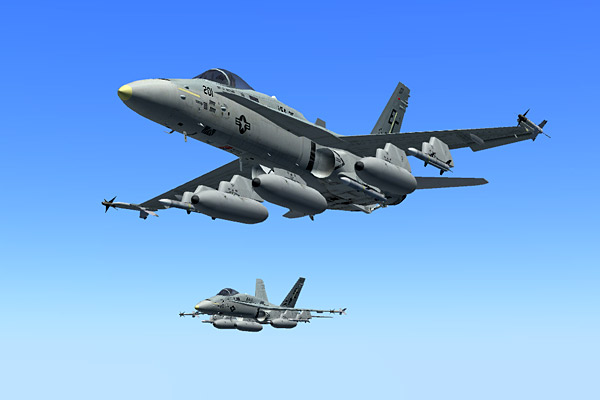
“Screw this. If they come any more south we won’t be able to stop them tagging the Boat.” He selected squadron common. “Rabbit. Let’s angle this pattern and slip a little north.”
![]()
I am using too much reheat, and I was not carrying a full fuel load for this trip. Kuwait is only a few hours south, after all. But nevertheless, there is one less enemy and I have burned through the jamming. There are three left and we are about to merge. I select my R-27T and choose FIO mode, placing my radar in standby. As the enemy flight flashes toward me, I start a hard turn, invitingly presenting my plan view to them as they pass in a hail of tracers. I know these aircraft now. F-4s. They can only be Iranians. But why? Is not the Americans’ war with Iran over? Steadying up, my R-27 tones out in my headset, and I let fly, immediately reactivating my radar and selecting BVB-Vertical Scan mode.
![]()
Alfa Kilo had, at last, got whatever message he needed to get. The task force was on high alert and launching more Hornets. The escorts were all dashing to battle stations, their radars searching the sky. And Tigger and Rabbit were on the pointy end of the spear. They knew that one of the combatants was a Russian-built jet, an Su-27 of some type. The others, of course, were Iranian F-4s. The Sukhoi had already done-in one of the four attacking Phantoms and was closing on a second. But the element was reforming and lining up for an IR missile shot.
“Ah, hail naw.” Tigger selected TWS and brought AIM-120s online. “Fox 3. Times two.”
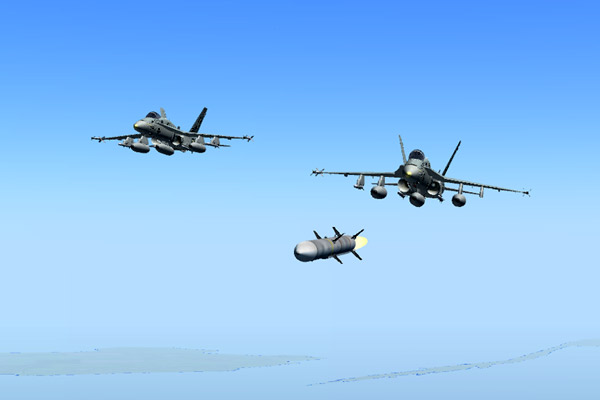

![]()
I did not see the death of the Iranian element, of course. I was in the dogfight with the last F-4! My SPO-15 showed the approaching radars and gave me the launch warning, but I was engaged, it was all I could do to keep the Iranian I was after from changing me from predator into prey. I popped chaff and flares from my APP-50 dispenser and whispered a prayer to God. And keyed in my R-73, bringing up SHLEM helmet-track mode and lowering the eye-sight into place. The devilish Iranian took the fight to the vertical. I can fire almost sixty degrees off boresight, and my Vympel R-73 is fast like the snake. It spread the Iranian jet into smoking rubbish.

I took a breath, and pulled the Crane into a hard turn with the canards, looking feverishly for the element. There were no radar lock-ons, from the SPO-15. But the sky was alive with radars above and below. In my earphones, a challenge-American fighters, closing fast, calling on me to stand down. A carrier is close. We have taken our fight too near, and they have scrambled to intercept — it must be they who saved me from the last two Iranians. I acknowledge, and affirm that my intentions toward them are not hostile, underlining that by canceling the SPS-171 and making my nose cold, putting the N-001 on standby.
“Seagull 159, Mercury 6-1. Turn right heading 245 and maintain present altitude for an escort to Kuwait International.” They were aware of me, he said, and that my government had asked their assistance. As I prepared to comply, red warning lights flashed. “Toplivo nizkogo. Toplivo nizkogo.” The warning sounded in my headphones. I sighed. “Yebat’! Now what?” I keyed my mic. “Mercury 6-1, Seagull 159 bingo, bingo. I haven’t enough fuel for Kuwait. Declaring emergency.”
Tigger rocked back in his seat, knocking his helmet on the pad in frustration. “Man, we just saved this gal and now she’s gotta ditch.” He thought a minute, and Rabbit got to the thought first, on their squadron common frequency. “Tig. Have her go to Mother and ditch that big blue puppy. We can have a helo pick her up.”
“Good call, rookie.”
For my part, I was heartily wishing that I had thought to pack an ASP-74 flotation kit. I was going to have to go for a swim, and I was sure that Major Grachev would not like me losing one of his precious aircraft. Nevertheless, ditching would serve the purpose, because the seawater would dissolve the package I carried. And I would survive. Over the radio, the carrier was calling me, vectoring me to a rendezvous with their helicopter. We were about thirty miles from the carrier. In times like these, it is good that I have flown with the American air force in training, and even in combat some years ago against the mujahids. I know much of their air procedures.
With the Hornets in close, we orbited the spot. I leveled out, and called to Commander Tyler that I was about to eject. I closed my eyes, pulled the rings between my legs.
Nothing happened!
I was too tired to swear this time. Reaching down, I snapped circuit breakers, and tried again. Still nothing!
“Seagull 159, what’s the holdup?”
“Er… Houston, we have the problem…” I was told that I sounded somewhat sheepish. I explained to Commander Tyler. “You’ve got to be kidding. How much time you got before that thing goes down?”
It was not long. It was also beginning to look like my luck finally had run. But the crafty Americans had one more trick up their sleeves. It was Lt. Oliver, whom they called “Rabbit”, who hit upon the audacious plan that saved my life.
“That thing’s got an arrester hook. Isn’t the Su-33 a navy bird?”
“Da; in fact, I have landed on our carrier. I learned the procedures in test pilot school.”
I did not see where he was leading.
“No way, Rabbit,” Tigger cut in. “Her landing that thing on the Boat? The skipper’ll never go for that.”
“She’s dead if we don’t. She can’t eject! Chrissake, Tig, call and ask’em!”
And so began a flurry of activity. What Rabbit and Commander Tyler proposed was not as far-fetched as it may sound, after all. It is very common for the navies of other countries to fly from the American carriers. Even the French Rafale and their bomber, the Super Etendard, have flown from them. But make no mistake, this is dangerous in the extreme. The arrester system must be calibrated just so. And no Crane has ever landed on the American carriers.
It is amazing how much is the same between Kuznetsov’ and the Americans in landing procedures. We have four wires, spaced the same as they. We use a Fresnel lens landing system, as do they. Many of the procedures were similar, as the Marshal Controller and the ship’s Landing Systems Officer patiently, yet hastily, explained to me what to do. While Lincoln made ready, clearing the decks and readying her firefighting equipment, we tested my hook and my gear, everything worked fine. Everything but my ejection seat. I would be most interested to see what had happened there, assuming I lived through the next few moments.
It was decided for me to try a normal carrier “trap,” or landing. It is safer than flying into their restraining net; the Su-33 is rated for such landings, and I have done them before. Even so, Lincoln, the carrier, took no chances. They cleared their decks. Much of their force was airborne, and could be diverted if something went wrong. In an amazing display of courage, the LSO advised me that she would be in the pit, aft, to help me in. Risking her life, for a fellow aviator! So selfless, these Americans!
As I set my HUD for English measurement (a plus for flying the 503rd’s aircraft) and started out of the marshal stack, I knew that I might get at most two tries. Then, the end. I set to HAB navigation mode, the most uncluttered, giving me a pitch measurement and turn/bank indication without looking down into the cockpit. I opened my mic to call inbound, to begin the dangerous dance with death.
“Seagull 159 inbound your 180, angels ten,” and I gave my fuel. Essentially, not much left. Marshal was very reassuring, smooth, un-worried.
“159, marshal; you may depart the stack, and commence your approach. We’re going to want your airspeed at about 250 knots, with descent rate of about 4,000 feet per minute. Can you convert that on board from metric?” He then gave me the same figures, converted. So efficient! I began to feel confident.
“At five thousand, we’ll want you to slow that rate of descent to 1200 feet per minute. Call ‘platform’ to me when you’re there, 159.”
I could see the carrier in the distance. It was so small! I have been on these ships before. They are larger than Kuznetsov’, where I learned this trick, but still, it is much like landing a pony on a balalaika.
“Ten miles. Lower flaps to full, and deploy your gear and hook. Advise down and locked.”
“159, Three green lights, hook down and locked.”
“Five miles. On glide slope. Continue descent.”
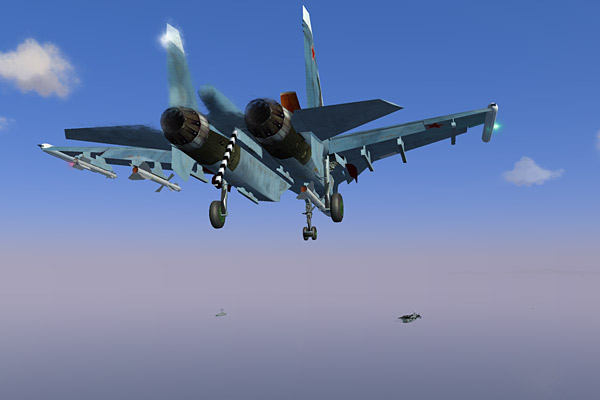
The carrier steadily grew. I knew that in moments, I would flare and lose the picture. Then, I would have to trust my instincts. I looked for the lights, what is known as the “ball.” The “ball” would be on the left, and it would tell me, give me optical cues. I could see the glowing green and yellow lights, very bright! I watched them carefully, using the throttle to control the Su-33’s rate of descent. It is not too different from the landing system aboard Kuznetsov’, I thought. One must be careful, keeping the “ball” steady, between the green arms. I spared a look at my fuel gauge. It was barely even registering anymore. I would only have one chance.
“159, call the ball!”
That meant for me to tell the controller whether I could see it. “Seagull 159, I see the ball.” I gave my remaining fuel as well. “I only have enough remaining for one pass.”
A new voice cut in; calm, strong. “159, Paddles. You’re low, add a little more power.” The carrier’s landing officer. “Fly the ball, keep it centered. You’re doing great.”
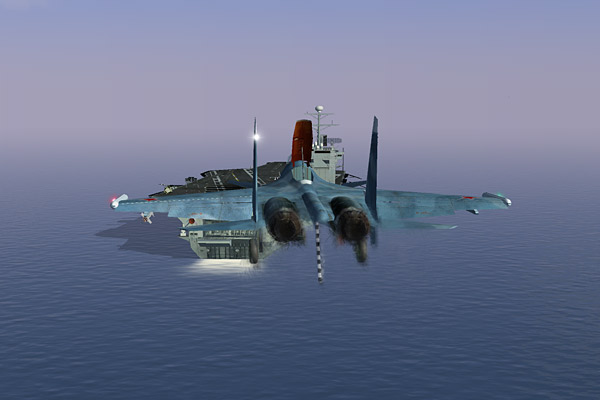


It is said that landing on an aircraft carrier is a controlled crash. This is truthful, and never more so than on this landing. My AL-31s began to choke as I crossed the fantail. It was now or never.
The Su-33 slammed into the deck, pulling up hard against the wire, throwing me bodily into my straps, and recoiling back as reflexively, I firewalled the throttles.

The engines howled for a moment, then flamed out and died. Out of fuel.
A moment of silence, and then a mob of sailors in helmets, goggles, and multicolored shirts, all over my bird! One found the outer handle for the canopy, and it smoothly hissed open. What? But what about my ejection seat?
I later found that the safety pin that arms the ejection seat broke off when we removed it. I was ensured that the pin was out, but the 503rd’s ground crew did not notice that the pin was broken when it was withdrawn. A manufacturing defect that nearly cost an aircraft and my life.
High in the tower, the carrier’s CAG turned from the windows to squeeze the thoroughly sweat-drenched shoulder of the air controller. “Well done, Murphy.” Turning to the ship’s captain, who was shaking his head, still looking out at the mob swarming around the Russian jet, he drained the mug he held and said, “that’s a two-wire trap, by God. Not bad.”
“Bring that pilot up here, CAG. I want to know just what the hell the Iranians are playing at and why Mother Russia’s suddenly loaded for bear and sending long-range fighters down here.” The Captain brushed his hand back through his thinning, sandy hair, and CAG could see where his nails had scored his palm. They’d all taken a big chance with this Russian.
“Make it my office, Jack.” The captain turned, to see the imposing figure of the task group admiral standing there. “There’s a reason we had to do this. I’ll give you the scoop when we get there.”
As for me, I removed my helmet and stepped gingerly out onto the ladder provided, making my way to the deck where a sea of sailors parted for me. Waiting, several camouflage-clad, armed Marines. Of course, the reception party. Facing their officer, I saluted. “Major of aviation Alexandra Dmitirevna Andreeva. May I come aboard, sir?”
Of course, I was required to hand over my Makarov. A quick pat-down did not reveal the package secreted in my jacket, however. And there would be more still that would surprise me. I was whisked immediately, without further ceremony, into a passageway, and then a maze of tight corridors, to a plain white door. Another camouflage-clad Marine stood there, regarding me with a stern look as the officer sharply rapped on the door. I was ushered inside, and there faced three very senior men indeed.
I stood at attention and saluted. I recognized the rank insignia. Two of their captains, and an admiral, no less! Quite the welcome. The admiral returned my salute, and motioned his men to chairs. “You can stand easy, Major. I’ll take the package you’re carrying, now. Please.”
I feigned ignorance. “What is “package” you speak of, sir?”
He leaned back and unsuccessfully stifled a snort. “Come off it, Major Andreeva.”
The CAG cut in. “We know you, Sacha. I was a squadron commander on Reagan when you were working with Bones. You’ve got a red-wrapped package. You’re among friends here. Your package is for us; at least, for our government. To be delivered by way of your consul in Kuwait to the U.S. Ambassador there. Sit down.”
He proffered a chair, and the admiral opened a desk drawer as I perched nervously on the chair’s edge.
“This telex is for you. It came in while you were in the landing pattern. I assume that you recognize the authentication codes?”
Well, there was nothing for it. I unzipped an outer jacket pocket and brought out the plastic-wrapped “biscuit” from my mission brief, breaking it open to reveal the special authenticator given me for this mission. Only my contact would have the countersign. Taking the telex message, I carefully compared the authentication code at the top to that I held. My eyebrow raised at the match. It came from Moscow itself! Were the Americans that good? I looked suspiciously at the men, paused, then reached into my jacket and brought out the red package.
Taking it, the admiral let out a long breath. “You deserve to know this much. Your government is helping us avert a terrorist strike in the United States. This package contains a crucial code to disable a weapon of mass destruction that the terrorists have, one stolen from a former Soviet ally. You may have saved a lot of lives by trusting us. Thank you.” He nodded to the CAG, who stood up and addressed me.
“Major Andreeva, please accept our hospitality. It is Thanksgiving day tomorrow, and I’m sure the air wing would love to have you with us. We’ll figure out how to get your bird back in the air later on.”
That night, I shared quarters with Kathy Andrews, the brave LSO who helped talk me down. I do not know why they call her “Tribble.” Americans have strange callsigns! I had the callsign “Spice” stuck on me when I flew with an American air force captain they called “Sugar,” back during the war with the IRLF. “Sugar” and “Spice.” But not too nice. And of course, the CAG knew of that, and soon enough all of them were using that old name for me.
An aircraft carrier is a city at sea. The USS Abraham Lincoln has thousands of people aboard. Over five thousand men and women! Their culinary specialists worked night and day to prepare meals for their crew for this, their special day. I was invited to dine that day with the air group officers in their own wardroom. They call it “the dirty shirt,” because the dress code in the air group’s wardroom is not what it is in the more formal dining area occupied by the officers of the ship’s company. I would also take a meal with them, before leaving the carrier, but the air group had first call on me. I met my saviors, Tigger and Rabbit! Commander Tyler keeps his head shaved, so as not to show the gray hair. So distinguished. And Rabbit is so very young; I wonder, was I ever so fresh-faced, so eager? They are so far from home, valiantly sacrificing themselves, serving their country. I understand them well. Would I not give my all for the Rodina? And so it was, that I asked Tigger about this fascination for the turkey that they eat when giving thanks. After all, was this not nearly the American national bird? I have heard their F-14 fighters referred to as “turkeys,” also. In English, one word can have so many different meanings.
And the food! So much of it; not only the turkey, but ham as well. And prime rib, fresh vegetables, potatoes and gravy, and bread-crumb stuffing! I stuffed myself, I am ashamed to admit. And ensured that I complimented the enlisted men at the counter on their work — it was marvelous.
Do you know that the American navy grades its pilots on each and every landing that they make? My “grade” was presented to me with great ceremony at the dinner, by Tribble, complete with a video that everyone watched. “Well, you overshot the start high, then flew through the glide slope and had to add-on power at the end. But you stayed centered and got the 2-wire, a little early onto the deck but a fair pass. Three points, not too shabby all things considered!” Meaning that it was my first carrier landing in many years and my very first on one of theirs, yet I managed not to do anything very unsafe. Any landing one can walk away from is a good landing, da?
I especially was touched by the prayer the CAG offered. In giving thanks for our splendid meal, he praised his officers and ranks, gave thanks for their service and their safety, and he thanked God for my life and my arrival safely aboard their ship. Even though we are not always allies, our countries, here on the level of the warrior we understand one another and we are friends. It has ever been thus. I pray that each of you finds such peace and happiness this holiday.

SimHQ would like to say a special thank you to Thomas “Thomas DW” Weiss for the superb screenshots he took in this latest installment of the Sacha Chronicles. There were far more outstanding images than could be used in this story, so we have a screenshow of his entire set of 158 images. Be sure and visit Thomas’ web site, LockOnFiles. It’s a great site for flight sim fans!
If you haven’t read the Sacha Chronicles, take some time and read them. They’re well worth the time! You’ll find the entire collection here.
We want your Feedback. Please let us know what you thought of this article here.

